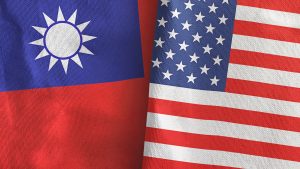Dennis V. Hickey

On October 21, U.S. President Joe Biden committed yet another faux pas with respect to the U.S. security commitment to the Republic of China (ROC), more commonly known as Taiwan. When asked whether the United States would defend Taiwan in the case of an attack by China, the president replied, “Yes, we have a commitment.”
It’s not the first time and likely won’t be the last time that a US administration has scrambled to walk back a president’s unscripted comments on the topic. On April 24, 2001, when President George W. Bush was asked if the U.S. had a commitment to defend Taiwan, he replied, “Yes, we do…and the Chinese must understand that.” Just like Biden’s gaffe, officials quickly sought to “clarify” Bush’s comments and insisted that there was no change in U.S. policy.
To state it succinctly, the United States has never had an iron-clad security commitment to defend Taiwan. That policy of “will-they-or-won’t-they” has worked well for over 70 years and should continue to serve American interests. Here is why.
In 1949, China was split by civil war. The ROC government retreated to Taiwan and a few smaller islands, while Mao Zedong’s Communist forces occupied mainland China. After the outbreak of the Korean War, American aid poured into Taiwan and the two sides negotiated a bilateral defense treaty in 1954. But there were limits to U.S. support. The United States insisted on an exchange of letters agreeing that any Taiwan attack on the mainland must first be approved by Washington – its seems President Dwight Eisenhower did not want to be dragged into another messy civil war.
Moreover, the administration deliberately sought to “fuzz up” the security pact in such a way that the territories covered by the document were unclear. This prevented the United States from being treaty-bound to protect the tiny offshore islands (technically a part of Fujian province). Similarly, the so-called “Formosa Resolution,” a Congressional measure authorizing the president to protect the offshore islands in 1955, only permitted the defense of territories like Quemoy or Matsu if such an attack was judged to be a prelude to a full-scale attack on Taiwan.
The U.S. formal defense pact with Taipei, albeit equivocal in key respects, worked well for 25 years. It helped prevent war. In 1979, however, the United States abrogated the treaty as a precondition for establishing full diplomatic relations with Beijing. In its place, the U.S. Congress passed the Taiwan Relations Act (TRA) that President Jimmy Carter signed into law on April 10, 1979.
Today, the TRA, three U.S.-China Communiqués, and a series of presidential statements guide the United States’ relations with Taiwan and China. Legal experts, however, agree that the TRA trumps all other documents and statements of policy. The law promotes the maintenance of economic linkages and “unofficial” political ties. Perhaps most significant, however, are the provisions for Taiwan’s security. Like the “fuzzed up” 1954 defense pact, the TRA provides a U.S. president with the option of going to war to protect Taiwan. It does not contain an iron-clad security guarantee. Unlike the mutual defense treaty, however, the TRA cannot be abrogated by a president – a president must seek Congressional approval to abandon Taiwan. The law also provides a U.S. administration an option to sell arms to Taiwan.
The TRA has successfully promoted peace and stability across the Taiwan Strait for over four decades. But it is not without its detractors. Some fear the law cannot deter Beijing and that Washington must make its intentions clear. Others argue that TRA holds the potential to give a president the “green light” to entangle the United States in yet another foreign conflict – one that might escalate into a cataclysmic nuclear conflict.
Criticisms of U.S. policy hold some merit. But the current policy allows for flexibility that might otherwise be lost: options remain open. For example, the flexibility enables the United States to assist in the defense of Taiwan if it chooses to do so – but a U.S. response is not guaranteed. The TRA also enables Washington to establish a linkage between U.S. policy and the actions of other states. Depending on circumstances, U.S. military support can increase or decrease. Finally – and most important – the TRA encourages both Beijing and Taipei to behave responsibly. In other words, uncertainty breeds restraint.
From time to time, the United States makes some modest adjustments in its relationship with Taiwan. Many of these are largely symbolic. But some are more meaningful, particularly ramping up U.S. support for Taiwan’s drive to gain a voice in the World Health Organization (WHO). This is one initiative that deserves increased American attention. But any change in the U.S. security commitment to Taiwan may very well prove disruptive to the dynamics of the U.S.-China-Taiwan triangle.
It is likely that the current policy – albeit ambiguous and contradictory – will continue to serve American interests. As R. Nicolas Burns, Biden’s pick to be U.S. ambassador to China, observed during his confirmation hearings, strategic ambiguity is “time tested” and “the smartest and most effective way” to prevent a war across the Taiwan Strait.
No comments:
Post a Comment